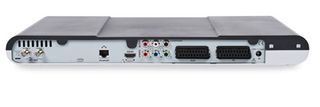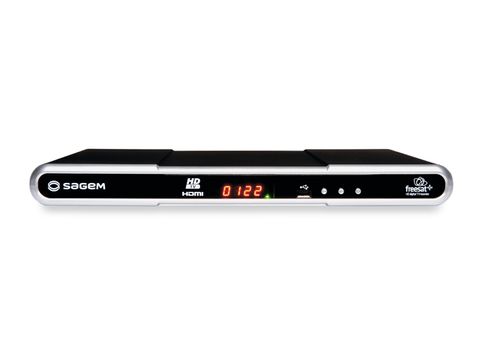TechRadar Verdict
Overall, the 94500 proves a capable if unspectacular Freesat recorder, lacking many of the features we liked from the manufacturer's Freeview PVRs
Pros
- +
Price
- +
Dual Freesat SD/HD recording
- +
Big hard disc
Cons
- -
Not great for non-Freesat use
- -
No recording exporting
- -
No multimedia playback
Why you can trust TechRadar
We were fairly blasé about Sagem's inaugural Freesat receiver – the DSI86 – awarding it 69 per cent in our November 2008 issue. Hot on its heels comes its first Freesat PVR, the Sagem DTR 94500.
Suitable for recording both high and standard definition channels, it comes with 500GB (tested here) or 250GB (as the 94250S) hard drives.
Twin tuners allow for recording of up to two standard or high-definition channels at once (while playing back a recording at the same time if you wish) and it's Freesat+ certified, blessing it with such features as automatic series recording.
Build and connectivity
Aesthetically, the 94500 isn't that far removed from the DSI86, although it's thinner and wider and has a silver edging running around the fascia. The fan in our test sample also proved rather noisy at close range.
An amber-coloured LED readout shows, among other things, the number of the channel you're watching and whether you are recording. To the right are three operating buttons and on the left is a USB port.
Sagem's Freeview PVRs routinely offer multimedia playback and even the ability to export recordings via USB, but that is not the case here. Sagem doesn't rule out the latter in future but this is liable to be SD recordings only as most HD broadcasts are likely to remain copy-protected on Freesat.
Rear connections mirror those on the DSI86, but this time with twin LNB connectors (and loopthroughs) feeding the two tuners. AV out comprises twin Scarts, an HDMI output supported upscaling to 1080i and hi-fi and SP/DIF audio outputs.

An Ethernet port means that the recorder should be compatible with BBC iPlayer when it launches widely on Freesat (supposedly any day now) and potentially ITV Player when it arrives in 2010.
The remote is the same as that found with the Freesat zapper box, where the inclusion of PVR buttons now seems logical (though it still has unused multimedia buttons). The most oft-used buttons are well positioned, though greater variation in button size wouldn't have gone amiss.
Setup
As is now standard for Freesat, the initial setup requires you to enter your postcode to receive localised variations of ITV and BBC channels before it starts scanning for Freesat channels. Channels are stored in a main list from which they can be separated into four favourites marked A to D.
If you're banking on being able to get more than Astra 2 and Eurobird you may be disappointed to learn that the 94500 doesn't match up to the likes of the Humax Foxsat HD-R when it comes to dealing with channels not on the Freesat EPG or found on other satellites. There's no DiSEqC switching or motorisation and no pre-stored satellite or transponder data, so it pays to know the precise details of what you're looking for.
Frequency and symbol rate and channel type (DVB-S or S2) must all be entered into a non-Freesat channels menu before scanning.
Located channels can be added to the main list or 'favourited'. Non-Freesat channels do not get an EPG.
Basic use
The EPG (and Sagem's distinctive icon-led menus) retain the DSI86's grey-with-amber highlights colour scheme, which is still a little garish to our eyes. It's also odd, considering that Freesat has a habit of insisting that manufacturer's products adopt a more uniformly black appearance.
You can view a programme grid of data allowing for eight channels onscreen at a time with information displayed in two-hourly segments. This can be sub-divided into bespoke EPGs for specific channel genres such as news and entertainment.
You can skip day by day or back and forth in two-hourly chunks. A vertical red bar shows you where you currently are in the schedule. Synopses are shown at the top of the guide, together with a progress bar.
Pressing OK starts a recording and you're prompted as to whether you want to record one episode or the entire series. Pick a show on ITV1 that's also in HD and you're asked if you want to record it from ITV HD (still a red button channel on Freesat) instead.
PVR and multimedia
The 94500's two tuners allow you to record two (standard or high-definition) programmes at once while playing back a recording from the hard drive. A one-hour recording occupies 1GB of space when in standard definition, or 1.5GB if in HD.
As well as recording from the guide, you can record by hitting record or there's an eight-event timer with once, daily, weekly and weekday only repeat options. You can also record while in standby. Recordings are stored in the library labelled by name, day and date where they can be re-named, PIN-locked and organised into user-created folders.
When browsing the recordings list, you can have the selected programme running in a small window on the right of the screen. Timeshifting or 'deferred TV' as it's called here, is possible (including while recording another channel) and the receiver automatically keeps a running cache of what you watch, which can last up to two hours.
You can fast-forward and rewind timeshifted material recordings at speeds of up to 100x indicated by onscreen arrows and a small progress bar appears in the top left of the screen.
Again, unlike Sagem's Freeview PVRs, there are no editing features or as mentioned an option to export recordings elsewhere via its USB port, or even MP3 or JPEG playback.
Performance
As with the zapper, Sagem has included upscaling of standard-definition channels to 720p or 1080i via HDMI and results are discernibly sharper – especially from channels broadcasting at higher bit rates. 'Proper' HD also looks as good from BBC HD, especially at 1080i, and RGB Scart pictures are also on a par with the average Freesat box.
With no post-processing involved, the quality of standard and high-definition recordings is faithful to the source. Audio performance is clear, especially via the S/PDIF outputs.
We experienced no incidences of failed recordings and fast-forwarding and rewinding is handled smoothly.
Follow TechRadar Reviews on Twitter: http://twitter.com/techradarreview

